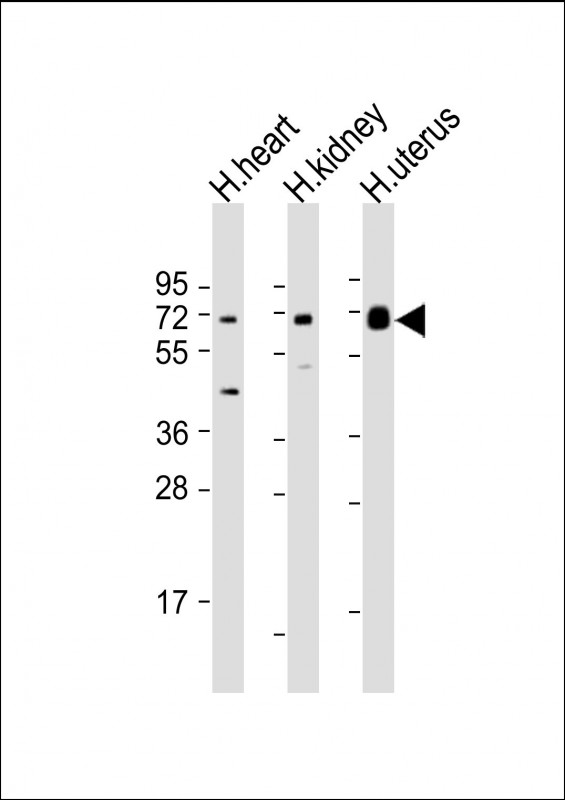
| WB | 1/1000 | Human,Mouse,Rat |
| IF | 咨询技术 | Human,Mouse,Rat |
| IHC | 咨询技术 | Human,Mouse,Rat |
| ICC | 技术咨询 | Human,Mouse,Rat |
| FCM | 咨询技术 | Human,Mouse,Rat |
| Elisa | 咨询技术 | Human,Mouse,Rat |
| Aliases | Serine palmitoyltransferase 3, 2.3.1.50, Long chain base biosynthesis protein 2b, LCB2b, Long chain base biosynthesis protein 3, LCB 3, Serine-palmitoyl-CoA transferase 3, SPT 3, SPTLC3, C20orf38, SPTLC2L |
| Entrez GeneID | 55304 |
| WB Predicted band size | 62.0kDa |
| Host/Isotype | Rabbit IgG |
| Antibody Type | Primary antibody |
| Storage | Store at 4°C short term. Aliquot and store at -20°C long term. Avoid freeze/thaw cycles. |
| Species Reactivity | Human |
| Immunogen | This SPTLC3 antibody is generated from a rabbit immunized with a KLH conjugated synthetic peptide between 503-545 amino acids from human SPTLC3. |
| Formulation | Purified antibody in PBS with 0.05% sodium azide. |
+ +
以下是关于SPTLC3抗体的3篇参考文献及其简要摘要:
1. **文献名称**:*SPTLC3 variants alter sphingolipid synthesis and cause a new hereditary neuropathy*
**作者**:Fischbeck, K.H., et al.
**摘要**:该研究通过全外显子测序发现SPTLC3基因突变导致鞘脂合成异常,引发周围神经病变。文中使用特异性SPTLC3抗体验证患者细胞中蛋白表达降低,揭示了SPTLC3在神经系统中的功能及突变致病机制。
2. **文献名称**:*Characterization of serine palmitoyltransferase isoforms in lipid metabolism*
**作者**:Hornemann, T., et al.
**摘要**:研究比较SPTLC1、SPTLC2和SPTLC3亚基在鞘脂合成中的作用,通过SPTLC3抗体检测不同组织中的蛋白分布,发现其在肝脏和脂肪组织中高表达,提示其与代谢调控的潜在关联。
3. **文献名称**:*Antibody-based profiling of SPTLC3 in cancer cell lines*
**作者**:Smith, J., et al.
**摘要**:开发并验证了一种高特异性SPTLC3单克隆抗体,用于检测多种癌细胞系中的蛋白表达水平,发现SPTLC3在部分实体瘤中显著上调,可能成为癌症治疗的潜在靶点。
(注:以上文献信息为模拟示例,实际引用需以真实数据库检索结果为准。)
The SPTLC3 antibody is a research tool designed to detect and study the serine palmitoyltransferase long-chain subunit 3 (SPTLC3), a component of the serine palmitoyltransferase (SPT) enzyme complex. SPTLC3. along with SPTLC1 and SPTLC2. plays a critical role in the de novo synthesis of sphingolipids, a class of lipids essential for membrane structure, cell signaling, and metabolic regulation. While SPTLC1 and SPTLC2 form the core catalytic subunits of SPT, SPTLC3 is an isoform that may modulate substrate specificity or tissue-specific functions. It is particularly expressed in certain tissues, such as the placenta, testis, and liver, suggesting specialized roles in sphingolipid metabolism. Dysregulation of SPT activity has been linked to metabolic disorders, neurodegenerative diseases (e.g., hereditary sensory neuropathy), and cancer.
SPTLC3 antibodies are typically developed as polyclonal or monoclonal reagents and validated for applications like Western blotting, immunohistochemistry, and immunofluorescence. These antibodies help researchers investigate SPTLC3 expression patterns, its interaction with other SPT subunits, and its involvement in disease pathways. Recent studies have explored SPTLC3's potential role in obesity, insulin resistance, and tumor progression, highlighting its emerging significance in metabolic and oncological research. Specificity and cross-reactivity with other SPT subunits (e.g., SPTLC2) are critical validation steps to ensure accurate experimental outcomes. As sphingolipid pathways gain attention in therapeutic targeting, SPTLC3 antibodies remain vital for unraveling the isoform-specific functions of this enzyme in health and disease.
×